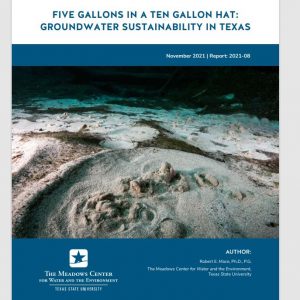Five Gallons in a Ten Gallon Hat: Groundwater Sustainability in Texas

Despite the hopes and desires of scientists, engineers, and planners, the projected future of groundwater production in Texas is unsustainable. About 95 percent of locally-expressed desired future conditions are based on water-level declines, groundwater is currently being produced at 1.8 times the maximum sustainable amount, and groundwater is expected to be produced 2.4 times the maximum sustainable amount. However, Texas has an opportunity to consider groundwater sustainability since current production for all aquifers excluding the Ogallala Aquifer is only 80 percent of the maximum sustainable amount of production.
Of the 21 aquifer systems analyzed, 13 are currently being produced at or below the maximum sustainable production amount (5 of the 8 major aquifer groups and 8 of the 13 minor aquifers). However, again excluding the Ogallala Aquifer, groundwater conservation districts have made almost twice as much groundwater available for use in 2070 than can be produced sustainably in these aquifers. In other words, Texas plans to unsustainably produce groundwater from more aquifers in the future, reducing the number of aquifer systems being produced sustainably from 13 to 5 (resulting in sustainable production from only 2 of the 8 major aquifer systems and only 3 of the 13 minor aquifers).
To better understand how groundwater is produced sustainably, I identified five types of sustainable groundwater management in Texas: (1) hydrologically-forced, (2) court-forced, (3) legislatively-forced, (4) desire-driven, and (5) de facto. There is also the situation where it is politically difficult to achieve sustainability, generally when production far exceeds sustainable production, thus requiring controversial production reductions. Hydrologically-forced sustainable production seems to only occur when aquifers are small and highly productive. In Texas, part of the Edwards and Gulf Coast aquifers are sustainably managed due to court and legislative forcing, the latter in response to the former. Through the establishment of desired future conditions, a dozen or so groundwater conservation districts have explicitly expressed a desire to manage groundwater resources sustainably. And there are cases of aquifers being produced sustainably without any management action—at least for now. But there are also many aquifers not produced sustainably because production or permits have exceeded maximum sustainable production.
Based on the results of this study, I recommend that (1) groundwater conservation districts include decadal water budgets in explanatory reports for desired future conditions or the Texas Water Development Board include these budgets as part of the delivery of modeled available groundwater numbers, (2) the Texas Water Development Board carefully consider the process of estimating maximum sustainable production if and when they are required to provide those estimates, and (3) the Legislature consider requiring maximum sustainable production as another factor for groundwater conservation districts to consider when establishing desired future conditions.